#shin megami tensei herald
Text

hand of god
#shin megami tensei#shin megami tensei herald#smt#archangel gabriel#archangel michael#lucifer#donodoodle
31 notes
·
View notes
Photo

'Advent' by Kazuma Kaneko and Megumi Shiraishi, 2005. Scanned at 800 DPI, 11232x8109.
https://drive.google.com/drive/folders/1xwyT5lNIiE8myFIEtK0QaPQk05DgXwsL?usp=share_link
First off, I would like to say thank you for 100 Tumblr followers! I scanned this piece today in celebration of that. Hope you’ve all been enjoying the awesome Kaneko Kontent, I won’t stop scanning until Atlus finally hires a hitman to put me down (I’ll defeat them).
Anyway, this Shin Megami Tensei II piece was drawn for the cover of Kaneko Works Vol. 2 (SMT II art book) and consists entirely of Divine and Herald demons from, you guessed it, SMT II. Among them can be seen Satan, Metatron, Camael, Sariel, Kushiel, Ophanim, Raguel, Haniel, Tzaphkiel, Principality, Dominion and Power. It’s an easy guess that the motif if this piece is law, hence Metatron, Principality and Dominion t-posing to evoke the shape of the cross.
101 notes
·
View notes
Photo


Herald Mastema (大天使 マンセマット) offering a path to world salvation.
Done in the style of 'salvator mundi' religious iconography.
Shin Megami Tensei Strange Journey © Atlus
Artwork © EerieAyres
#mastema#shin megami tensei#strange journey#iconography#angel#angels#angel art#angelology#abrahamic mythology#shin megami tensei strange journey#smt strange journey#smt sj#smt#megaten#atlusfaithful#artists on tumblr#my art#digital art#painting#illustration
63 notes
·
View notes
Text
Let us see the terror of heaven
I was thinking a while ago today about the way angels are consistently designed in Shin Megami Tensei vs the way the Law alignment is sort of steadily portrayed in later games. It's a weird trip but hopefully where I'm going will become clear.
Most of Shin Megami Tensei's angels actually hue fairly close to the "traditional" image of angels, as fair-looking winged humans. We see this for instance in Shin Megami Tensei's Angel.
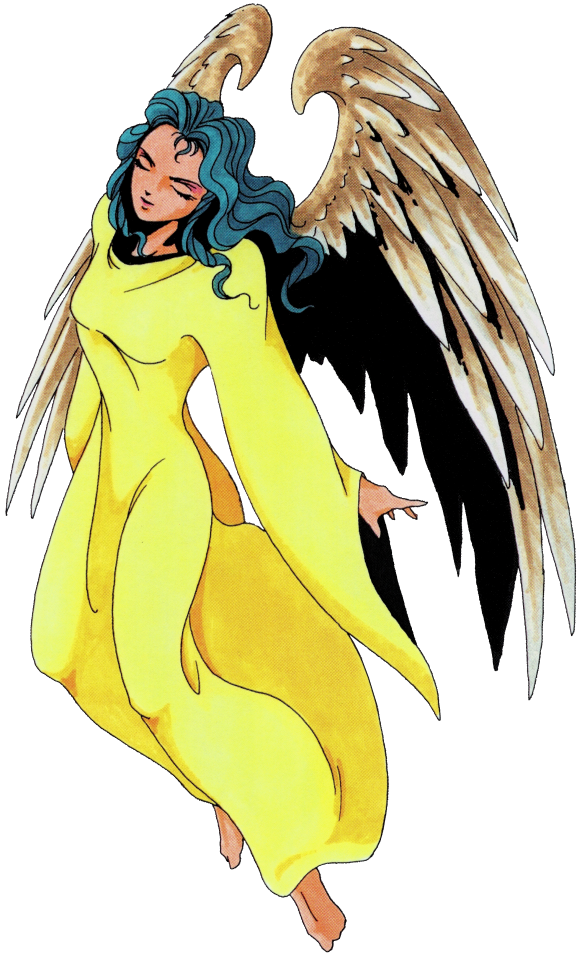
In nearly all of the angels in the Tenshi clan:
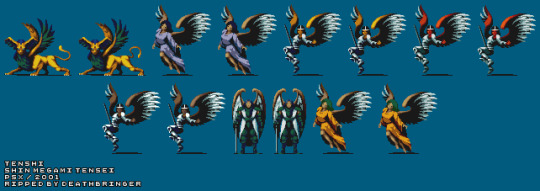
And of course, the Four Archangels/Seraphs/Heralds. Let's just use Uriel as an example here:

There's also Haniel and Kazfiel whose designs both follow traditional Christian depictions of seraphs. We'll bring up Haniel's art here:
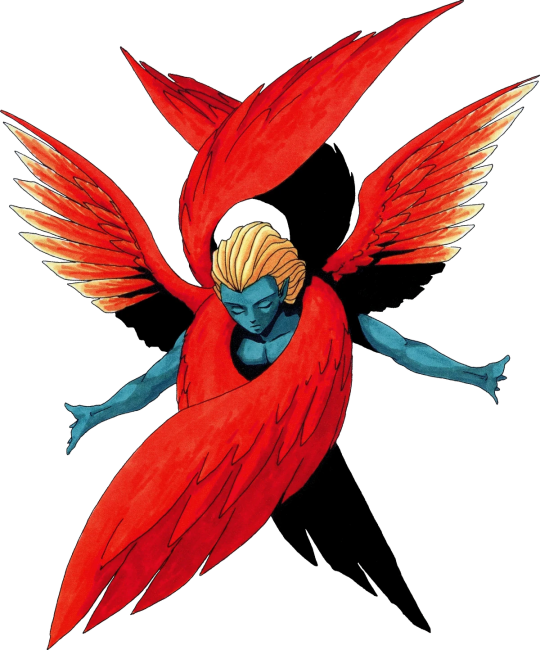
But then we get to Shin Megami Tensei II where we really start to see the "Biblically accurate angels" trope emerge in earnest, where we see the more human/Hellenistic-looking angels alongside some pretty eldritch entities in the Daitenshi clan. For example, Tzaphkiel:

Or how about Ophanim, which seems to be based around Ezekiel's vision of the cherubim:

And then of course there's SMT 2's Satan:
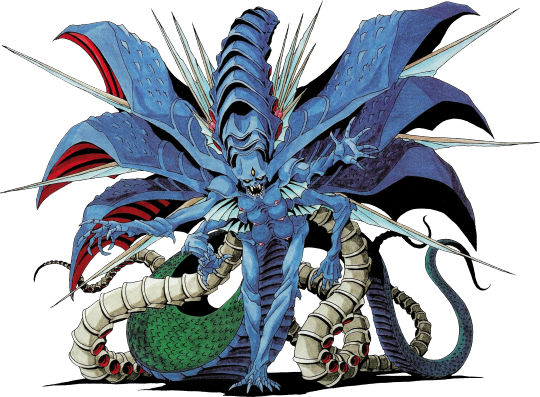
Devil Summoner and Soul Hackers can be seen as developing the inhuman aesthetic of SMT's angels as extending from the "Biblically accurate angel" trope. Let's start with the Tenshi clan in Devil Summoner:

And some of the Daitenshi:

Then Soul Hacker's Tenshi:

And Daitenshi:

With Shin Megami Tensei IV it seems that one of the guest artists, Keita Amemiya, took the inhuman direction for angel design to the nth degree in terms of his approach to demon design in general as reflecting the idea of angels and demons as artificial beings.

At this point I should get to where I'm going here. For a while, at least a decade ago, I might have favoured the idea of the angels as strictly inhuman, or even artifical, possibly to convey the externality and alienness of the repression of the order of God. Keita Amemiya seemed to really lean on that idea, though the designs were certainly rather poorly executed at least for the Four Heralds. But thinking about it, I think the older designs for the Four Seraphs appeal to me for more than just being the classic designs from SMT 1 and 2.
Even though the "Biblically accurate" design direction is very suitably weird both for SMT's context and the linking of the strange and alien to representation of dreadful aspects of divine awe, I find that the more humanlike representation of angels in the context of the Law alignment works better for what, in my mind, I prefer to see. To understand where I'm going, let's look at SMT IV and Apocalypse. Here, the Law alignment is much as it is in SMT I and II, in that it can understood in terms of a single-minded devotion to the order of God, and to the extent that the forces of Law are ruthless in their actions, willing even to wipe out all of Tokyo in order to preserve the Eastern Kingdom of Mikado. In Apocalypse, you see YHVH's "true form" as a monstrous chimera the likes of which, as I remember Eirikr noting, you would probably see as the formulaic final boss of literally any JRPG.

To my mind, it serves to very obviously signify YHVH as unambiguously evil, which, oddly for SMT, is represented as similarly unambiguously demonic. Of course it might be argued that the conceits of Sethian "Gnosticism" are also in play. I think that the opposite approach would be better. SMT IV's approach seems to tie the order of God and the atrocity that the forces of Law undertake to uphold as, all along, the manifestation of a demonic will. But the better idea for me is that all of the same atrocity is done not by monsters but by the traditional figures of light.
Every scheme to dominate the universe, and every massacre that follows to support it, every terror that befalls mankind for its perceived failure, I prefer that we see all of it under the auspice of the traditional figures of light. That would be a far more fitting adage of the inversion that SMT is known for. As Valerio Mattioli said of Rome as portrayed by Luchino Visconti, hell lies in the celestial vaults. And what better way to illustrate that then all of the violence and terror of Law being the instrument not of monstrous chimeras but of celestial form. Of a "beauty" that hides unfathomable violence within itself. And I don't want SMT to be the only place where you can find this idea. Oh no no no I think more media should play with that idea, more art should go all in on this kind of aesthetic-moral inversion.
Update: it occurred to me that I've forgotten something. I forgot to talk about SMT V.
When it comes to SMTV, we see echoes of SMTIV Apocalypse's handling of Law and the violence of order, in that it both reasserts its treatment of that as the affect of an actually demonic will and presents Abdiel's desire to reassert God's order as a plunge to towards the demonic. Hence you see the angel Abdiel transform from sort of an angelic Princess Padme in gold armour into an actual fallen angel, who even gets reclassed as the only Law-aligned member of the Fallen clan.
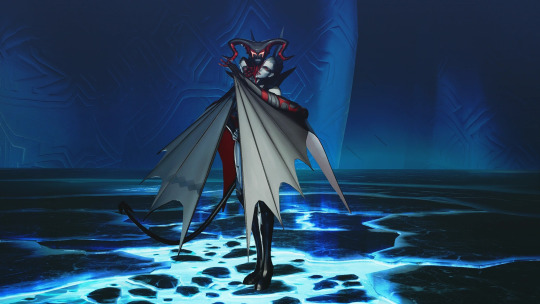
Not to mention her attempt to become a Nahobino resulting in a transformation into a giant demon centaur whose design seems to recall Sirene's fusion with Kaim in Devilman.

Of course, in context this is all supposed to emerge from the premise of God's death, Abdiel's denial of that death, and the resulting desperation to restore order. But, again, that desire as strictly the affect of the classically demonic to me misses the point. Yet, given the obvious resonances with Nocturne, where three of the main characters merge with their demonic sponsors, it's worth pointing to an obvious contrast: Baal Avatar.
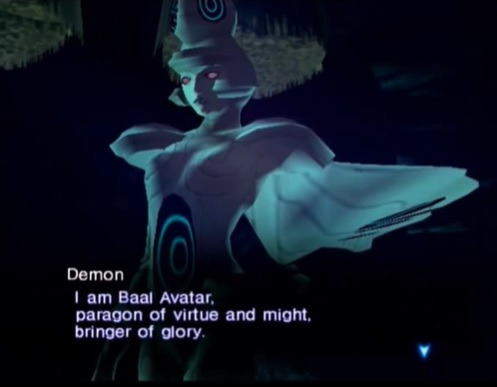
And moreso, the fact that before you see Baal Avatar you witness Chiaki slaughter the Manikins, ramble about how the strong deserve to crush the weak, and then in a flash of light three out of the four archangels (namely Raphael, Gabriel, and Uriel) appear as her allies, which you fight.
youtube
Now there's a setting where the representatives of Social Darwinist violence and atrocity also make no bones about what guides them: the idea that they're making the world beautiful and promoting the ultimate good. Their radiant appearance is not to be understood as a deception covering up some inner demonic nature or demonomania but instead only reflects their seemingly divine conceit. It's not only that they believe they are paragons of virtue. Everything they do, they do as figures of light. And you, a monster among monsters, a cursed being in the world of demons, might oppose them and might just stop them if you choose to. It's really hard to think of anything else that has that angle. It's also somewhat concerning to think that future games might miss the mark.
The development exemplified by Abdiel's transformation into literally a fallen angel ultimately lends not only to certain ideas about the hope that there might be something "unambiguously good" about Law, but also the idea that all the bad things about it are all about concert with the demonic, which is ultimately familiar to the conceit that all of the negative aspects of Christianity are simply the manifestations of a falsification of Christianity, that the "real" blasphemers, heretics, and demons are actually just Christian fundamentalists. But I'm not interested in that idea. I'm interested in the worst that humanity has to offer being contained in its loftiest aspirations of order and in turn represented in the figures of light, because I'm interested in the idea that it is in the name of "the Good" that atrocity always manifests, and for which we cast it into a shadow of the human, in evil.
What we are striving to forget is that the worst deeds in the world are always either utterly human or surely the work of God. Nothing demonic could come close. So let us see more inversion that reflects that insight. The insight that, so far, SMT is among the few media to portray, let alone portray as brilliantly as it often has.
#shin megami tensei#angels#law alignment#michael#gabriel#raphael#uriel#haniel#kazfiel#satan#merkabah#tenshi#daitenshi#seraph#Youtube#shin megami tensei ii#shin megami tensei iii: nocturne#shin megami tensei iv#shin megami tensei iv: apocalypse#shin megami tensei: devil summoner#devil summoner: soul hackers#shin megami tensei v#abdiel
24 notes
·
View notes
Text

Bonus: A video showcasing my art process behind my Kaneko art style study, featuring my original character Adlai Tiernan. Also featured in this piece is Herald Seraph, Divine Cherub, Divine Throne, and Divine Dominion.
I strayed off model at times, but by re-painting over my mistakes I eventually found my way into recreating Kaneko's style.
Kazuma Kaneko (金子一馬) is the artist for old-school Shin Megami Tensei and Persona.
Estimate: 75 hours
Shin Megami Tensei © Atlus
Character, Artwork © EerieAyres
#shin megami tensei#persona#wip#timelapse#artists on tumblr#kazuma kaneko#art style#original character#shin megami tensei iii#smt nocturne#persona 2#devil summoner#raidou kuzunoha#art wip#work in progress#speedpaint#art process#art video#digital art
7 notes
·
View notes
Note
Dunno if you've ever heard of SMT (Shin Megami Tensei) or not but I always see HH Adam as a Herald race (a race for high ranking angels and their alignment is always Light-Law) race demon and a Fallen race (a race for fallen angels, mostly Ars Goetia demons. Their alignment is always Neutral-Chaos, the only exception of this was Fallen Abdiel, who is Neutral-Law instead) demon if Sinner Adam was a thing.
ahh I'm so sorry! I didn't know this game. I read it now to find out what it was about. What did you mean to say then would be that if Adam remained as a fallen angel he would be on the same level as the Ars Goetia? - If that wasn't the case, I'm sorry!! - so, I don't know if Adam would have this position - or even power equal to these entities - because Adam was a human before, he was not born as an angel. I don't know if I answered your question sorry!!
1 note
·
View note
Photo

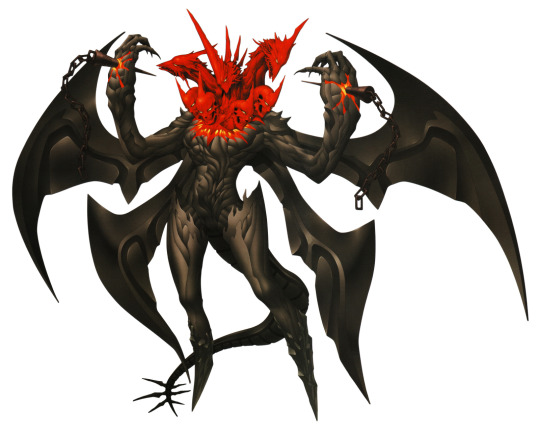
Oh my gosh, SMT5 spoiler time is finally over (as if it really mattered, lol) so I can finally post this stale comparison between Lucifer and Satan. Wow, they got the peg legs and goofy big hands and pose and everything and one’s a robot.
Oh yeah, robot. You know, I hope Doi didn’t make Lucifer a robot because of the existing robot angels as that would miss their point: besides the UFO theme, the humanoid robotic angels (so Metatron, Sandalphon, Victor) exist as artificially-created bodies made by God for the ascended Enoch and Elijah. And Victor as a prototype receptacle for a “voice,” I think because his body is incomplete and inarticulate as if the voice is inhabiting an inanimate object.
I designed [Metatron] as a cyborg because it is said that he was actually a human (Enoch) turned angel. There are a lot of angels who feel like special systems working for God, so I’d say they might have a mechanical side to them.
There is no visual representation left of Victor, since he is only identified as a voice that offered inspiration. This is why I chose to interpret him as a sort of Metatron prototype.
https://dijehtranslations.wordpress.com/2021/11/29/shin-megami-tensei-devill-summoner-world-guidance-angels-and-friends/
Herald Victor
The angel who sent the divine revelations to Saint Patrick. It is said you can hear his voice, but not see him, so I made him similar to a robot.
Herald Sandalphon
Made to be Metatron’s twin brother. Apparently he used to be human as well. Talking about the prophet Elijah here.
https://dijehtranslations.wordpress.com/2016/08/08/488/
In Metatron’s case, the image I had in mind was not an appearance he had chosen by his own volition, but something mechanic, manufactured to do what he’s told.
https://dijehtranslations.wordpress.com/2016/08/08/kaneko-comments-on-beelzebubs-and-metatrons-designs-in-smt-ii/
32 notes
·
View notes
Photo

SMTIVA: TERMINAL NATIONALIST BRAIN
TONIGHT, November 1st, 9:30 PM EST/8:30 PM CST, we’re heralding the end of Halloween festivities with a return to Shin Megami Tensei IV: Apocalypse! We’ll be tackling the only challenge quest of narrative consequence before finishing off the Cosmic Egg and taking our first step into the endgame proper. The stream; watch it; tonight!!
Stream: https://www.twitch.tv/streamingknowledge
Archive: https://www.youtube.com/channel/UCXYyuYZQg2tPKOB-eS7BYrw?view_as=subscriber
7 notes
·
View notes
Photo
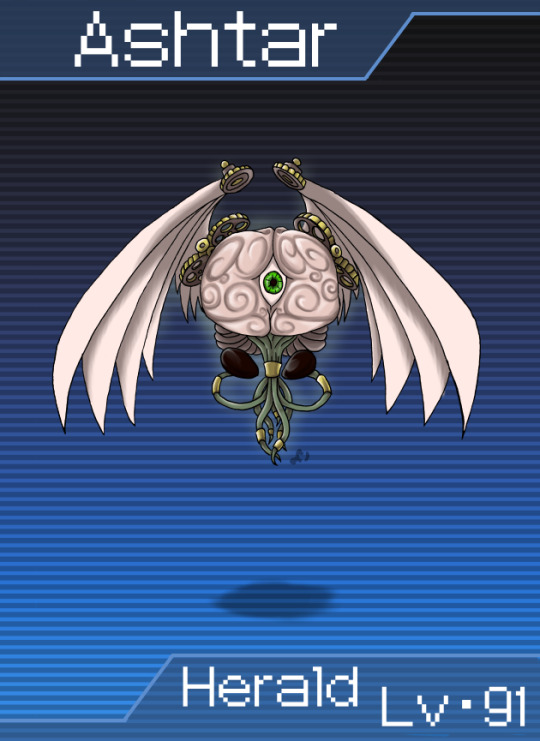
02 of 05 - Modern Compendium: Chaos - A Waste of Desert Sand - Herald Ashtar
There are actually very few original seminal myths in the extraterrestrial pantheon. UFO belief really took off during a period of time in America where beliefs labelled as “exotic” -- Hinduism, Buddhism, and other religions from Asia -- were the mysticism du jour, and so elements of them were blended into UFO belief as it grew. Although the Contactee Movement generated a wide swathe of new UFO figures, most of them quickly faded away and were forgotten, to the point where very few survive today as figures of actual belief.
Ashtar, however, is one of these rare seminal mythological figures. First decribed by George Van Tassel, the man who started the mass Contactee gathering known as the Giant Rock Convention, Ashtar was originally said to be an extraterrestrial being of exceptional power, who contacted people on earth through direct telepathy. This was actually a significant step away from the Contactee convention of the time, which was largely interested in people being taken up into alien spacecraft. The overall message was largely the same, though -- Ashtar was a benevolent being, concerned about the human race and all the terrible weapons we seemed to be building.
Ashtar was massively popular almost from the instant of its inception. Contactees loved the idea that Ashtar could contact anyone, anywhere, and all you had to do was slip into a “psychic trance” and begin mumbling. The Ashtar myth also opened the door to synchretism between UFO religions and Spiritualism. As Ashtar’s popularity grew and grew, it began to inspire knockoffs and imitators, many of whom went on to gain followers of their own. Today Ashtar is a part of several large UFO religions, from the Aetherius Society to the Ascention Movement, and stands as an important part of the history of UFO belief.
As you might expect with such an important part of a major modern belief system, Ashtar ends up being pretty powerful. It has access to a number of powerful skills, and like all Heralds, its level is very high. Ultimately, though, Ashtar does get beaten out by more modern extratrrestrial beliefs -- not because belief in Ashtar has waned, but rather because other alien gods has surpassed it. But then every good parent looks forward to the day their children surpass them. ^^
For more info on this and every other demon in the Modern Compendium, have a look at our extensive Data File, right over (here).
#Shin Megami Tensei#Persona#UFO#Alien#Paranormal#Herald family#Modern Compendium#I was goin' for a kind of Omoikane thing here ^^
20 notes
·
View notes
Text
Sraosha è il demone presentato oggi da Shin Megami Tensei V con questo video
Sraosha è il demone presentato oggi da Shin Megami Tensei V con questo video
Vi riportiamo un interessante video di uno dei giochi più promettenti del momento tra gli utenti che giocano spesso a Nintendo Switch. Questo è stato pubblicato pochi minuti fa e si concentra nuovamente su Shin Megami Tensei V.
In questo caso, possiamo vedere più scene del titolo che si concentrano sul demone Sraosha, della razza Herald. Non dimenticate che altri video simili saranno disponibili…
View On WordPress
0 notes
Text
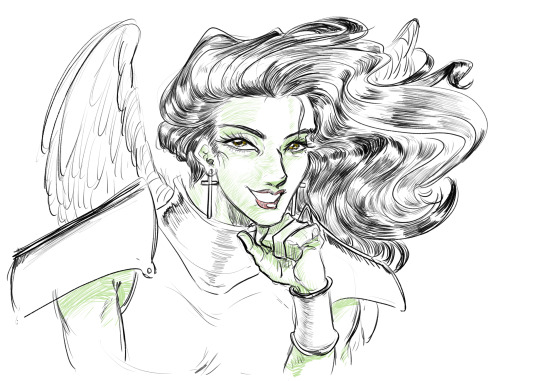
h
22 notes
·
View notes
Text
Shin Megami Tensei If...
(Part 8 of the MegaTen thing)
So, the previous main title in the franchise managed to close off its continuity in an effective, satisfactory, appropriately big manner. We wouldn't be looking at a new mainline game for 8 years this time around, so during that time a slew of spin-offs were released, the first of which being Shin Megami Tensei If...
Given these conditions, I can only speculate the designers gave themselves significant amounts of leeway as far as actually designing new stuff was concerned. Aside from 2 or 3 new pieces, all the music is recycled from SMT 1 and 2. The ones from 2 now have an actual melodic line, something that was strangely absent in their game of origin, so technically there's something new in them. Regardless, having just finished SMT2 prior to starting this game, two whole games with the exact same battle tracks was pretty grating to me.
Random art has also been borrowed from 2 in places. Most of the demons look the same, naturally, but some character art has also been lifted and modified slightly. Again, having just gone through 2, this feels like a weird milking of 2's material, as if they had stuff left over from its development and, in a Roger Corman-esque move, decided to just throw a new game together with it while they still had time. "If..." came out the same year as SMT2 as well, so good on them for being efficient with their assets...?
The gameplay, however, has undergone some changes. Most of them, I would say, actually make the battles more involving and fun. In SMT2, there were two "rows" of character boxes, but it made little to no difference in actual gameplay. Now, the party members in the back row can't use melee attacks, having to resort instead to either special skills or their gun. Furthermore, enemies won't be able to reach your back row guys with melee attacks, and they WILL target them a lot, so you can get some use out of it as well.
Ammunition is finally not just a piece of equipment anymore, and there's actually a counter representing how many bullets you have left (there's still no magazines or reload command, though, you're only limited by the standard max item stack size of 99). Sometimes, it can be annoying to keep restocking ammo and buying it in bulk, but I liked the potential the idea has of making you have to use your special ammo sparingly. This is something that could have solved SMT1's problem of overpowered status effect bullets, for example. It's underutilized here, however, and for the most part you can just buy regular bullets and call it a day.
Magic is a lot more effective this time, but the MP costs for spells are now very steep, so you'll still want to just stick to the support classics (tarukaja, rakunda, mediama, etc.) Instead of using attack magic. I would like to see magic being more useful in the future, though, and again, the potential has been opened and, with further tweaks, things can start heading toward great places.
With these changes, one again feeling like a contrarian, this game was harder to me than 1 and 2 were. Not a lot harder, mind you, but hard enough to demand some attention. In practice, though, this just meant that it took longer for me to properly set up all the essentials for having a breezy time with SMT games. Once it was ready, it was back to auto-battle time, but not always, though. I had to stop and change my moves quite a bit, especially as it was getting close to the end. The final dungeon throws enemies at you that are much beyond the level of one just playing the game normally without grinding, and things got pretty intense up there, forcing me to go back and readjust my demons and strategies a few times. Overall, I liked the raw battle aspect of it a lot more than I had previosuly with the franchise. It was more complex and involving, and felt like the systems were maturing. They're still juvenile here, but many cool things have begun to take shape, and I appreciate SMT If... for being their herald.
However, the unfortunate truth begins to creep in as I reflect about what it was all in service of. Bluntly put: The story and level design both suck. The plot is simplistic and inexorable; what would have been an arc in a game with a bigger scope is the whole game's plot here. There's no escalation and no surprises. The game sets things up, sends you jumping through pointless hoops on a meandering journey with the barest of juicy interactions, then quickly wraps things up and sends you on your way without so much as a second thought on its own events. Sure, there are multiple paths decided by who you partner up with at the beginning of the game, but outside of a superficial character study regarding the main villain, nothing of much intellect is contributed to a player's brain that hasn't been gathered in countless other, more involving RPGs before.
The hoops you have to jump through are simplistic mini-arcs surrounding sectioned off dungeon exploration. It reminds me of the very first game of the series, it's just a collection of errands with minimal interconnectivity. They're kind of short, too, and it results in the game feeling boring and repetitive at the same time it seems reductive and minimal in hindsight.
I suppose I have to talk about the Domain of Sloth, because it's the most baffling part of the entire game. The object here is to waste time. Several people are digging different holes in the walls, and there's either 7 or 8 "steps" between their start and end points. Each person digs a step further once the moon rotates fully, and each phase of the moon takes roughly, let's be generous here, 16 steps to move one sixteenth of a full rotation. Got that?
Well, if you javen't figured it out, the object of this "dungeon" is to directionlessly walk at least 2048 steps (16x16x8) until everyone is done digging their tunnels so you can go and see what's at the end of each. It's honestly elusive to me why they would think this was a good idea for a "puzzle". Did anybody ever playtest this? If they did, I have to assume at least someone was like "this is really boring and stupid, guys, shouldn't we change this puzzle around? Make the player have some agency over its progression?" and was quickly shut down by the higher-ups because they had deadlines to meet or something.
Regardless, other than that, I kind of dig the dungeon design of the other areas. Eventually they get pretty confusing and make liberal use of darkness tiles, teleport tiles, multiple stairways, holes that drop you to a floor below, and whatever tricks the dungeon design has accrued through the franchise's history. To some, it might be rage-inducing beyond the point where they can reasonably be expected to soldier on, and I can understand that, but I like it when the game doesn't pull any punches and is not afraid of using all aspects of its design. In my mind, it they really feel like sticking with the first person pseudo 3D bull honkey all the way through 1994, they might as well use the possibilities that such a manner of constructing levels gives them. For what it's worth, in the scope of dungeon crawls, it's not nearly as bad as it could be. I managed to clear the whole game with no outside help whatsoever, while in a game like Wizardry, I can barely get past the first floor with extensive hints as to what I could do to make life easier.
SMT If... does have things going for it. The battle gameplay is better than ever, a host of new, interesting ideas were being experimented with, and the level design, in a raw kind of fashion, showcased some bits that I personally found more captivating than dungeons in SMT1 and SMT2. However, the essence of a game like this is the story glue holding it all together, and this game falls flat on its face with its reductive, meandering, fruitless narrative. It fails to give the good aspects of the game any context, and turns it into a borefest. It has nothing over SMT2 besides being a little harder, and while it sows interesting seeds for future franchise titles to harvest, in itself, it fails to rise much above the previous entries in regards to interest. The experience of actually playing Shin Megami Tensei If... is one of disappointment and frustration at seeing the design milestones that, given the scope of the SMT series, the game fails to capitalize upon. My score for it is 4.4 out of 10, which is extremely harsh considering I technically had so much good to say about it, but this is not a game that's more than the sum of its parts. It's kind of like eating raw eggs, then gulping down some flour, chewing on a block of butter, and finally, sniffing sugar off the table. Could have been a yummy cake with some care, skill and preparation, but instead it's just a catastrophic mess to your taste buds.
1 note
·
View note
Text
Studio Pixel Spotlight: Cave Story

Original Release Date: December 20, 2004
Original Hardware: Windows PC
Chances are good that if you've only played one game in this spotlight, it's Cave Story. It's Daisuke "Pixel" Amaya's most famous and successful work, and it's been released on far more platforms than any of his other games. It has sold millions of copies, a fact made all the more impressive when you consider that the game in its most basic form has been available for free since the day it was released. It's also an important game, serving as a herald for the indie game boom that would follow in its wake. Its success not only won Pixel his financial independence, it also helped establish indie publisher Nicalis. Oh, and it's also a really terrific game. Any game that makes it this far on word of mouth would have to be, wouldn't it?
Of course, Pixel wouldn't have had any way of knowing just how big his little game would become as he toiled away on it for five long years. His previous games, Ikachan and Azarashi, hadn't garnered a lot of attention, after all. Still, he had a dream and refused to give up on it. As long as he could make something that would bring joy to someone else, that was good enough for him. So for a half-decade, Pixel went to his day job working on software for printers and came home to his personal project. There were false starts, ideas that never made it in, and items originally were meant to have purpose that ended up being vestigial. By the end of the process, Pixel was sure he would never make another game again. The game was finally completed as the year 2004 came to a close, and on December 20th, it was uploaded to Pixel's site. He didn't charge anything for his game, partly because he just wanted people to play it, and partly because he couldn't be bothered with the process of trying to collect money.
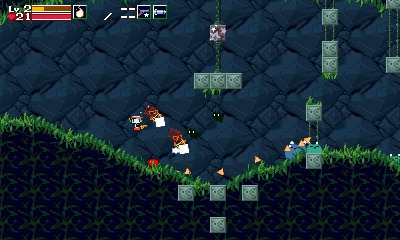
Before too long, the game caught the eye of a fan localization group called Aeon Genesis. They're one of the more respected romhacking groups around, with games like Shin Megami Tensei, Clock Tower, and Treasure of the Rudras under their collective belts. The group picked up Cave Story and did their thing with it, releasing the first English version of the game only a month after its Japanese release. By August of 2005 they had finished their final version, and the game had already begun to catch on in a surprisingly big way. With no AAA budget, marketing, or store presence, Cave Story had to rely purely on people enjoying it and spreading word of it around to their friends. That it became as big as it did at a time where social media consisted of MySpace and AOL Instant Messenger is a minor miracle.
Fans were soon porting the game around to just about anything that could handle it. A 2007 port to Sony's PlayStation Portable was one of the more popular non-emulator pieces of homebrew software for the system. For his part, Pixel had already moved on to making other games. He wasn't unaware of the popularity of his game, but if there's one word to describe Pixel, it's 'humble'. While there had been talk about bringing Cave Story to platforms like the Game Boy Advance, talk was all it was until he was approached by a man named Tyrone Rodriguez, a former editor at American gaming website IGN. In 2007, Rodriguez founded Nicalis, a small developer/publisher that targeted the burgeoning digital marketplaces on consoles. He convinced Pixel that the game would be a good fit for Nintendo's upcoming Wiiware service, and a partnership was formed that persists to this day.
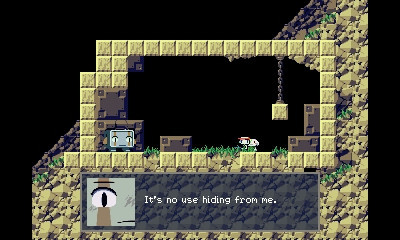
The Wiiware version from Nicalis wasn't just a straight port, however. Pixel and Nicalis felt that they should put their best foot forward with Cave Story and decided to touch up the game's presentation. They also wanted to add in some bonus content. After all, the game had been free up until this point. It might take some sweetening of the pot to convince players to pay. All of this work took time, and the Wiiware version of the game met with a few delays before it finally released in North America in March of 2010. A European release would follow several months later. Interestingly, this version of the game was never released in Japan. Pixel's home country would have to wait for the Nintendo DSiware version. That game launched in November of 2010 in North America, and came out almost exactly a year later in Japan. November 2011 also saw the PC release of Cave Story+, which was basically an enhanced version of the upgraded Wiiware port. This time, PC players would have to pay for the game if they wanted it. There were some gripes about that, but the game did just fine anyway.
That wasn't the only Cave Story action in November of 2011. That month also saw the release of Cave Story 3D on the Nintendo 3DS. As opposed to the enhanced but ultimately faithful ports of the game that had been released thus far, Cave Story 3D was a ground-up remake. All of the gorgeous pixel art was replaced with polygonal models, a change that didn't exactly go over well with a lot of players. This version of the game was also missing a lot of the extra content from the other versions of Cave Story, without much to make up for it. Truthfully, the most noteworthy thing about Cave Story 3D is that until the recent release of Cave Story+ for the Nintendo Switch, it was the only physical version of the game produced. It also features an appearance from Prinny, owing to the game being published by Disgaea creators NIS.

I played through Cave Story 3D earlier this year, and while it's certainly misguided in a lot of its changes, it's not terrible. You can tell it's coming from people who aren't accustomed to working with 3D graphics, however. Certain elements don't stand out as well from the backgrounds as they should, and everything just looks low-budget in a way that the original game ironically does not. The timing of the controls feels slightly off in places, too. I don't know if that's coming from any actual lag or is just a consequence of the dramatically different visual feedback, but it makes for a worse experience overall. If it's your only choice, the original game's quality still shines through well enough to give you a good time. I can't see how it could be your only choice, though, as the 3DS received its own native port of Cave Story for the Nintendo eShop less than a year later. I suppose it also has merit for die-hard fans just to see what a different version of Cave Story looks like, if nothing else.
As already mentioned, the latest release of the game is for the Nintendo Switch. I haven't played this version yet, so I can't speak to its quality. Since it's based on the Cave Story+ version of the game, I can't imagine that there's anything particularly wrong with it. Nicalis has quite a bit of experience with this title at this point, after all. The presentation seems to have been buffed up a little more, and a co-op mode will apparently be added to the game via a free update later this summer. The main draw here is that it comes in a lovely physical edition, complete with a NES-style manual, a mini soundtrack CD, a keychain, and other assorted goodies. For Cave Story fans, it's the first chance to own a real copy of the original game since it launched more than 12 years ago.

That's probably enough talking around the game, though. Let's talk about the game itself, because it really is a special one. Cave Story is a non-linear action-platformer in the vein of Metroid. You play as an amnesiac boy who wakes up in a cave. Once you've made your way out, you find yourself in a village of rabbit-like creatures called Mimiga. After a little looking around, you'll meet some of the antagonists of the game. Balrog and his sister Misery will be thorns in your side for most of the rest of the game, and you'll likely have your first fight with the former here. You don't have to, mind you. He'll ask if you really want to fight him, and you can say no. He'll just go away if you do. Either way, they'll take off with one of the villagers, setting the stage for you to finally leave the village.
While Cave Story plays out a lot like Metroid, it doesn't have a large, contiguous world. Instead, it's broken up into separate areas that you need to use transporters to travel between. Generally speaking, it's impossible to get to certain areas until the game wants you to reach them, so you can't sequence-break to the extent that you can in some games of this style. Nevertheless, there's plenty of exploration to be done. Items that increase your maximum life points and missile ammo are tucked away in various hiding spots, and there are plenty of secrets that have little point to them apart from being amusing. Outside of a couple of important areas, you usually don't need to backtrack to previous sections unless you missed something the first time. Most areas are also capped off with a boss battle, giving Cave Story more of an action-game feel than you might initially expect.

Taken in that context, the levels in Cave Story are really well-designed. Long enough to feel like an effort, but they never overstay their welcome. Even when the game presents you with a tedious fetch quest, you rarely have to track your feet over much of a distance. The worst instance of this is when Balrog's aunt asks you to find her five dogs. There's a particularly annoying stretch filled with enemies that you'll have to cross back and forth a few times. You'll also have to do a little backtracking if you want to get the game's best ending. Not that you're likely to stumble across that particular chain of feats without being told precisely what to do, mind you. Pixel set it up so that you would have to fight your gamer instincts four or five times without fail. Are you really going to let someone fall without checking on them? Search a boss room before talking to your friend? Not leave an injured but stable person to rest in a bed? It's kind of brilliant, in a slightly evil way.
It's part of what makes Cave Story so special, if you think about it. Pixel knows you. He sees you. He understands what you're going to try, for the most part, and makes sure something happens if you try it. One of the most frustrating things for me when I'm playing a game like Uncharted or Tomb Raider is when I climb, jump, or get myself to an out of the way location where it feels like there should be a treasure, only to find nothing. There should be a treasure here! That never happens in Cave Story. There's always something where you expect to find something. It might not have any point, but Pixel knew you would try it, and he left a little note of some kind for you.
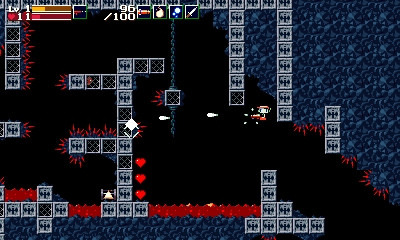
I suppose one thing I could criticize is the difficulty curve. Cave Story is surprisingly easy on its default difficulty setting until the very end. Upon entering the Final Cave, the game takes a big step up and doesn't let up until it's over. It's not impossible or anything. If you can beat the average Mega Man X game, you can get through this. But it's a very noticeable incline for a game that is otherwise pretty gentle and smooth. The game does try hard to coach you, at least. You can power up your weapons by collecting experience dropped by enemies after they're killed. Taking hits will cost you some of your current weapon's experience in addition to taking away some life. Losing your maximum level on a weapon dramatically decreases its usefulness, so you'll really want to avoid getting hit. I'm not sure if this was deliberate or not, but this essentially teaches you to strive for perfection when everything else in the game allows for quite a few errors. Theoretically, you should be ready for the last sequence of events by the time they come. Theoretically.
Considering the fact that the game was made entirely by Pixel on his own, it's incredible that there aren't any serious weak points, though. The graphics have a retro look to them, sure, but they feel authentic rather than opportunistic. The music is absolutely incredible. That's the one thing you can always count on with Pixel's games. Even the mini-games will have at least one or two outstanding chiptune tracks. Cave Story is packed with them. Most versions of the game beyond the initial release also have a lot of extra modes and unlockable goodies to check out.

For example, you could always find Curly Brace's panties by going through a secret area in her house, but they never did anything in the original version. In later versions, that item unlocks Curly Story, which lets you play through the game with the main character and Curly's roles reversed. That's a really weird way to open up a new mode, but it is what it is, I suppose. The point is that even though the main game offers a respectable 5-6 hour playthrough, there are lots of reasons to revisit Cave Story. This game goes above and beyond what you would expect given, well, just about everything about its origins and circumstances.
Ultimately, Cave Story is a genuine work of heart, the kind that wears that on its sleeve proudly. This game exists for no other reason than the fact that its creator wanted it to exist. It wasn't made to make money, or even to be popular. It wasn't made to make Pixel famous, and he even kind of fought his fame for a while. That alone doesn't make it entirely unique. I know many independent developers who are essentially doing the same thing. With the utmost respect to their work, however, not many of them turn out games of this size, scope, and level of polish. Even Pixel himself has had a lot of trouble doing it again. Cave Story is one of those lightning-strike moments in gaming history. I'm not sure if I'd put it on exactly the same level as Super Metroid, its chief source of inspiration, but it's not far below. And just like that game, it's utterly timeless. You would think a game like this would mainly appeal to people who grew up in the 8-bit/16-bit era, but the game is apparently quite popular with kids, too. That bodes well for the game's long-term status in the gaming canon, I'd say.
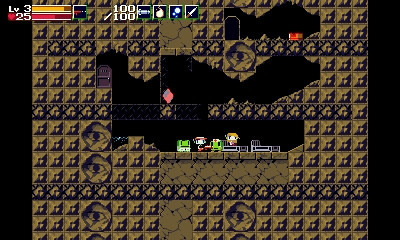
The dark side of that kind of success is that a lot of people keep looking to Pixel to do it all again. I'd argue that his most recent game Kero Blaster finally fulfilled that request in the broad sense, but not everyone would agree with me on that. Perhaps we all just need to accept that if someone can turn out a game like Cave Story even once in their life, that's a real miracle. Pixel has made many other fun games, and I'm quite sure he'll make many more. But Cave Story is Cave Story, and like any true piece of personal expression, it's doubtful that its creator could replicate the feelings it evokes even if he wanted to. I'd much rather that Pixel do the thing he was doing to begin with when he created Cave Story: whatever he feels like making. I'm sure he's got a lot of great ideas in him that don't involve going back to the well.
In the meantime, I have little doubt that we will continue to see re-releases and enhanced versions of Cave Story for a long time to come. A game that began its life as freeware has seemingly only gained value over the years, and people seem to be quite content paying to have the game available on whatever their newest piece of hardware is. For a game whose story is essentially about trying to get home, it's funny that so many people, including myself, find themselves coming home to Cave Story again and again.

Previous: Ikachan & Azarashi
Next: Megane & Guxt
If you enjoyed reading this article and can’t wait to get more, consider subscribing to the Post Game Content Patreon. Just $1/month gets you early access to articles like this one, exclusive extra posts, and my undying thanks.
#studio pixel spotlight#studio pixel#gaming#retro#cave story#nicalis#nintendo 3ds#nintendo switch#nintendo ds#pc
1 note
·
View note
Text

19 notes
·
View notes
Text

7 notes
·
View notes
Text



17 notes
·
View notes